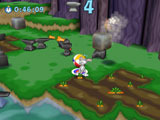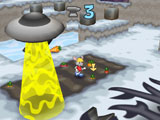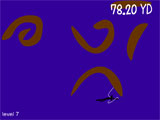Dodge Thousands of Anvils (And Like It!)
At the time of this writing, I have dodged 3,783 anvils (and not-so-successfully dodged 138 more). You see, that’s the exactly the kind of game Rabidlab has made with Dodge That Anvil. A game all about dodging anvils, for one, but also a game so meticulously polished and complete that of course it includes such statistics. So why have I dodged so goddamn many anvils? It’s kind of fun, actually, but also strangely addicting. I just couldn’t stop myself.
Mildly (Physics) Spiced
Although the Havok physics in Director power collisions and most of the motions in Dodge That Anvil, the game isn’t necessarily physics-based. As Jake Grandchamp–the one-man team behind the game–put it, the game is more “physics-enhanced”. The game does have its moments where the physics play out in unexpected ways. If you aren’t careful, explosions can rocket anvil corpses right back into the air and right into your rabbit face.
One of the common shortcomings of physics games is when the potential for using physics objects in interesting ways remains untapped. That’s certainly true of Dodge That Anvil–the world seems to be deliberately simple, almost blocky in design. It works really well as an art style, but I would’ve loved to see how things like slopes, more loose physics objects, and additional constraint-driven contraptions would’ve played out. Much of the appeal in playing Dodge That Anvil is that things are just complex enough to require your attention, though, so maybe additional complexity in the physics system would ruin that.
Flow Pacing
Something that fascinates me about Dodge That Anvil is its pacing. Hellacious anvils, and other more mundane objects, are constantly raining down on you. And I mean constantly–the longest delay between salvos is 5 seconds. The game actually started out as a physics test to stress the number of objects that could be spawned (a controllable character was used to control where the new objects would spawn).
The result is that something bad is always just about to happen to you. The game is very clear about what, when, and where, though. The survival skill here is simply paying attention. It requires a surprising amount of discipline to play well, especially compared to today’s modern games. You have no one to blame but yourself if you try to pick the largest carrot on a 2-second timer, which you know takes more than two seconds, but it seems to happen pretty frequently.
Dodge That Anvil becomes curiously addictive when you get into a good run. I think the game does a good job of putting the player into a “flow” state (in the Csikszentmihalyi sense of the word). There are a few barriers to that pleasant zoning out, though, principally of which is the game’s controls. I played with each of the three options–mouse, keyboard, and gamepad–for a few levels. Playing with a 360 gamepad (or similar) is far and away the most enjoyable and intuitive.


(Dodge That Anvil Game Screenshots)
Give It a Chance
I’ll be totally honest here. I first started playing Dodge That Anvil solely to come up with a review. I pushed through the first 30 minutes or so purely to play enough to write about it. I ended up playing all the way through the game, though, because I just couldn’t help myself. I crave those damn carrots now.
So give the game a shot. Find a gamepad and play until some of the more challenging and interesting anvils start to appear. Maybe it’ll suck you in too.
Download Dodge That Anvil Game (10.9 MB)
The full version of Dodge That Anvil is available for $19.99 from the Rabidlab website. There’s also a demo version that plays in your browser using the Shockwave plugin.
Related Posts:
- List of Physics Games
- I Know Rag Fu: Ragdoll Matrix Reloaded
- Turn-Based Pool Meets Rock-Paper-Scissors
- The Evolution of an Idea: Rolling Assault
Excellent Marble Madness-Inspired Physics Game
Hamsterball is a well-produced rolling marble game by Raptisoft. I haven’t seen much of John Raptis on the net lately, but last I heard he was working on a Hamsterball 2 (I imagine he has all the time in the world thanks to the earnings from the amazing Chuzzle). At its core Hamsterball is a reproduced version of Marble Madness, but it’s also one of my favorite remakes.
Solid Level Design
Hamsterball does a great job with level design. Many of the early levels are fairly static, but the later levels provide a lot of creative challenges (the Odd Race level with variable gravity directions will truly bend your mind). There doesn’t seem to be a general-purpose physics engine behind the scenes, unfortunately, as the number of other dynamic physics objects is very limited. The actual feel of your ball is pretty sharp overall, though.
Hamsterball has a very specific focus on racing; the game is all about how quickly you can get to the goal. It impedes this goal by requiring very controlled movement, which cuts both ways. On one hand, the high difficulty of the game magnifies your sense of accomplishment when you do manage a really good run through a level. On the other hand, the game can be something of a frustration generator at times. It’s particularly difficult to move uphill with the mouse. After failing miserably at some of the uphill sections I actually started playing with both the keyboard and mouse at the same time. This really improved my play experience by allowing sharper speed changes.
Not Very Open-Ended
One aspect of the game’s design that bugs me is the lack of open-endedness. Hamsterball is very faithful to Marble Madness in this regard. Compared to other rolling games with a focus on accurate player movement, like Super Monkey Ball, you can only fall a short distance and survive. This cuts down on the possibility for drastic shortcuts. Any shortcuts in the level must essentially be placed there by the designer (for an example of some truly insane player-discovered shortcuts check out this video of a flawless run through the original Super Monkey Ball).
It’s obviously just a matter of taste, but I prefer the softer, more puzzle-oriented gameplay of titles like Switchball. There isn’t a lot of room for failure in the gameplay of Hamsterball, and I no longer have the tenacious game-playing focus of my youth.


(Hamsterball Game Screenshots)
Solid Production
Hamsterball packs a lot of production punch. The art is somewhat minimal, but very consistently themed. The game has a very demoscene-like quality to it, which is due in large part to the excellent soundtrack by Skaven (of Future Crew). The Time Trial mode has a limited ghost feature, which is great if you’re anal enough to whittle your times down below the developers’. There are even some party games in the latest version. All in all, Hamsterball is a great value and a lot of fun to play.
Download Hamsterball Game (6.8 MB)
The full version of Hamsterball is available for $9.95 from the Raptisoft webpage.
Related Posts:
Double Dose of Fun with Double Wires
Doubles Wires is a small Flash game by d_of_i, a Japanese developer best known for his Falling Sands game (as well as Cat Sledding and some other physics games and experiments). Despite its small scope and limited production value, I think Double Wires does some things very well. So well, in fact, that it deserves unique mention here on Fun-Motion.
[kml_flashembed movie=”/files/doublewires.swf” height=”360″ width=”480″ /]
The Lure of Dangling
Swinging titles are a common theme in physics games, for whatever reason. Personally, I think the attraction is two-fold. One: Actually swinging around on stuff–in real life–is a lot of fun. But, it’s damn hard. While your imagination may have you gliding from object to object with the greatest of ease, in practice it’s slow, clunky, and rather inelegant (plus, it requires a fair bit of strength, and sitting around on computers all day isn’t exactly building up that requirement). Two: There’s a primal attraction to the activity. I was watching an episode of the excellent Planet Earth with some great chimpanzee and monkey footage. I really did have the urge to spend the rest of the day in the jungle canopy, swinging carelessly from one branch to the next.
I’ve already talked about some of the swinging games out there (Rocky the Monkey, String Theory, Squishy the Starfish), and there a bunch of others I haven’t covered yet. So why talk about Double Wires?
Simplicity Trumps Again
What impresses me about Double Wires is how successfully it boils the swinging concept down to its minimum essentials. You simply click to attach a cable–which connects exactly where you pointed–and that’s it. Variables like controlling when a cable releases, its retraction speed, or maximum length are simply removed from the player’s hands. As a result, the game is distilled to a very pure swinging mechanic (in fact, there’s very little you can do in the game except swing on things).
Some subtle complexity remains, though. The two wires the stickman uses to swing around are actually different lengths. And the timing of the automatic release requires you pay careful attention to when you last connected to something. I often myself connecting above a point, wishing to swing below and then forward–what usually happens, though, is that my cable releases just as I reach the low point and my stick figure tumbles to a painful demise.


(Double Wires Game Screenshots)
Just Enough Content
There are 10 different zones in Double Wires, which last to somewhere around 140 yards. After that, the level simply loops back on itself and you start over. It won’t take a skilled player very long to complete all of the zones, but I’d be surprised if anyone was able to do it on their first try. The game is just short enough–and just fun enough–that it’s hard to resist retrying once or twice.
Play Double Wires (26 KB)
I’ve seen Double Wires embedded in various Flash arcades around the web, so I went ahead and included it here. Be sure to check out d_of_i’s other projects on his webpage, though. It can take some digging, but there are more excellent physics games to be discovered there…
Related Posts:
- List of Physics Games
- Turn-Based Pool Meets Rock-Paper-Scissors
- Great-Looking Motorcycle Game, But Is It Fun?
- Throw Metal Pies at Ragdoll Clowns (Redux)
- A Brilliant Physics Game: Ski Stunt Simulator



 (Rate this game! 109 votes, average: 3.61 out of 5)
(Rate this game! 109 votes, average: 3.61 out of 5) My name is Matthew Wegner, and this site is dedicated to physics games.
My name is Matthew Wegner, and this site is dedicated to physics games.